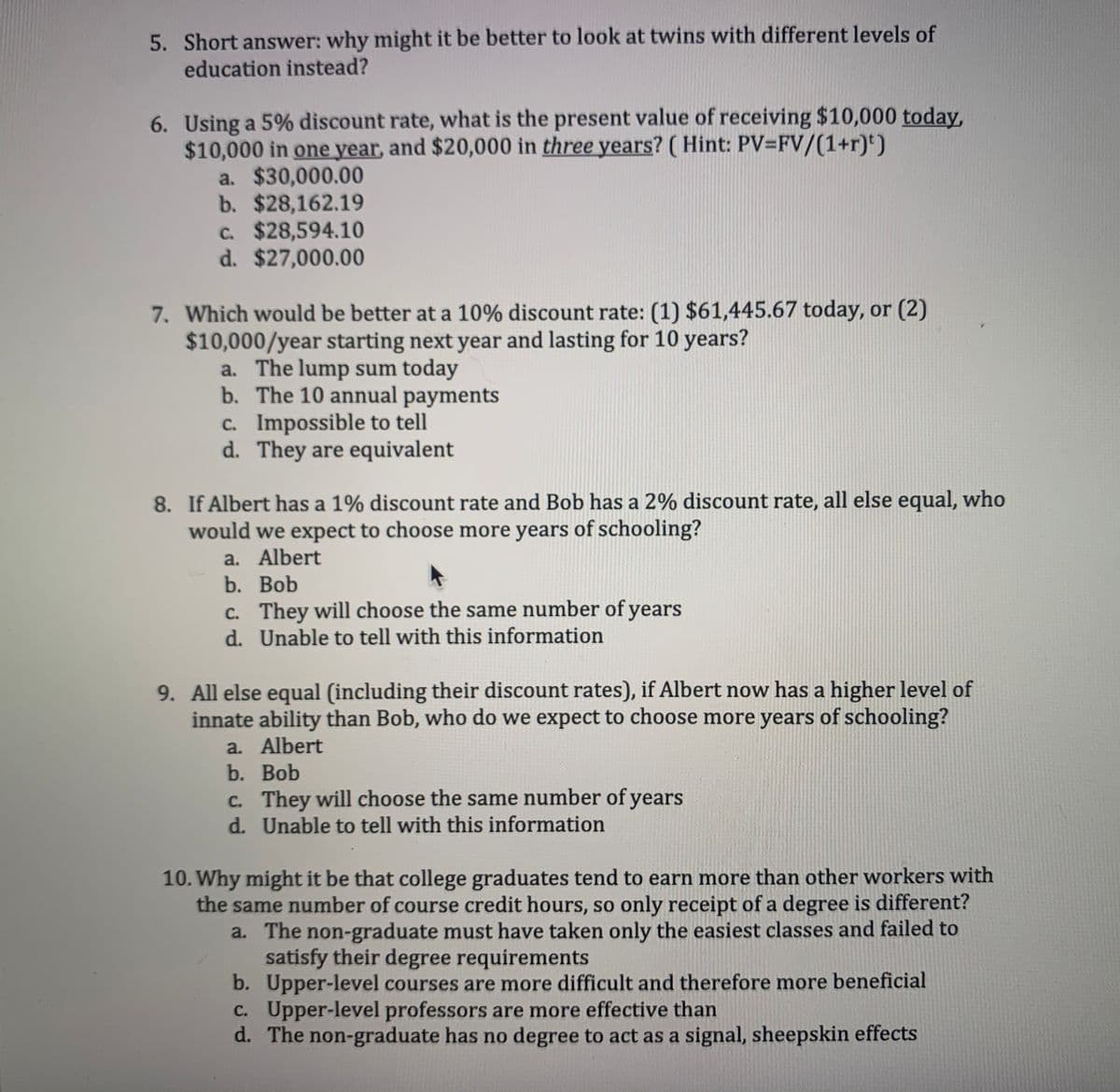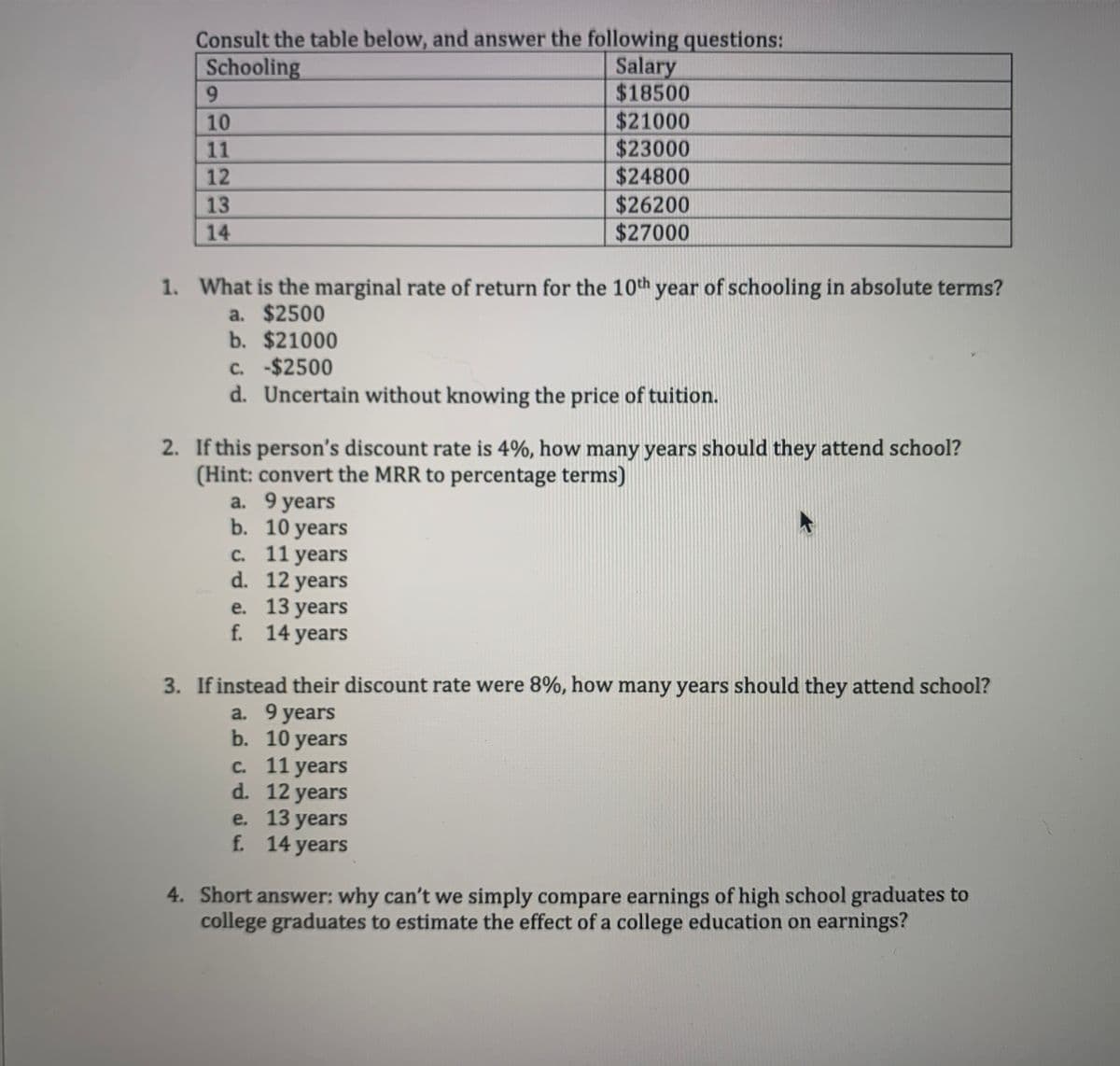6. Using a 5% discount rate, what is the present value of receiving $10,000 today, $10,000 in one year, and $20,000 in three years? (Hint: PV=FV/(1+r)¹) a. $30,000.00 b. $28,162.19 c. $28,594.10 d. $27,000.00
6. Using a 5% discount rate, what is the present value of receiving $10,000 today, $10,000 in one year, and $20,000 in three years? (Hint: PV=FV/(1+r)¹) a. $30,000.00 b. $28,162.19 c. $28,594.10 d. $27,000.00
Chapter13: Investment Fundamentals
Section: Chapter Questions
Problem 3DTM
Related questions
Question
Please help with #6

Transcribed Image Text:5. Short answer: why might it be better to look at twins with different levels of
education instead?
6. Using a 5% discount rate, what is the present value of receiving $10,000 today,
$10,000 in one year, and $20,000 in three years? (Hint: PV=FV/(1+r)')
a. $30,000.00
b. $28,162.19
c. $28,594.10
d. $27,000.00
7. Which would be better at a 10% discount rate: (1) $61,445.67 today, or (2)
$10,000/year starting next year and lasting for 10 years?
a. The lump sum today
b. The 10 annual payments
c. Impossible to tell
d.
They are equivalent
8. If Albert has a 1% discount rate and Bob has a 2% discount rate, all else equal, who
would we expect to choose more years of schooling?
a. Albert
b.
Bob
c. They will choose the same number of years
d. Unable to tell with this information
9. All else equal (including their discount rates), if Albert now has a higher level of
innate ability than Bob, who do we expect to choose more years of schooling?
a. Albert
b.
Bob
c. They will choose the same number of years
d. Unable to tell with this information
10. Why might it be that college graduates tend to earn more than other workers with
the same number of course credit hours, so only receipt of a degree is different?
a. The non-graduate must have taken only the easiest classes and failed to
satisfy their degree requirements
b. Upper-level courses are more difficult and therefore more beneficial
c. Upper-level professors are more effective than
d. The non-graduate has no degree to act as a signal, sheepskin effects

Transcribed Image Text:Consult the table below, and answer the following questions:
Schooling
Salary
$18500
$21000
$23000
$24800
9
10
11
12
13
14
1. What is the marginal rate of return for the 10th year of schooling in absolute terms?
a. $2500
b. $21000
C. -$2500
d. Uncertain without knowing the price of tuition.
2. If this person's discount rate is 4%, how many years should they attend school?
(Hint: convert the MRR to percentage terms)
a. 9 years
b.
$26200
$27000
10 years
11 years
12 years
e. 13 years
f.
14 years
c.
d.
3. If instead their discount rate were 8%, how many years should they attend school?
a. 9 years
b. 10 years
c. 11 years
d.
12 years
e. 13 years
f. 14 years
4. Short answer: why can't we simply compare earnings of high school graduates to
college graduates to estimate the effect of a college education on earnings?
Expert Solution
This question has been solved!
Explore an expertly crafted, step-by-step solution for a thorough understanding of key concepts.
This is a popular solution!
Trending now
This is a popular solution!
Step by step
Solved in 3 steps

Recommended textbooks for you

